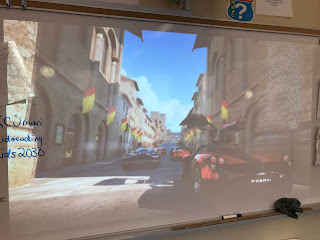I want to continue to use video games as a way to reach my students with respect to the curriculum and their learning but I also want to implement esports as an extra curricular activity/option for younger students who don't have the option of trying out for school sports teams; and who may not want to play traditional sports and be competitive that way.
One of the problems I am bumping up against is finding games that are accessible and appropriate for my students. Games where they can actually play video games and compete against each other, head to head - which is what esports is all about - have been hard for me to find. There is a plethora of games where students can compete against a clock but I would like to expose them to actually playing video games against someone else, in real time.
Let me provide you with some information about my context. Students have access to chromebooks which are connected to the Internet via wifi. I have found some games that I think are appropriate but are not accessible to my students via their access to the Internet. This has been causing me some heartache and has been getting in the way of what I would like to do with my students. I needed a solution. I decided that I would move away from the internet and the chromebooks and use a video game console so that my students could compete against each other.
I am fortunate because I have an Xbox 360 at home that is not being used. I have a bunch of sports games that are single and multiplayer. I also have the Xbox 360 Kinect sensor so the students can play games that allow them to be physical. I brought the system into the classroom and then had to deal with how to set it up. The easiest way to connect the system to my whiteboard projector was via HDMI but I didn't start there. The first thought was that I was going to need a VGA/HDMI connector in order to get the Xbox connected to projector. After some investigation and solid support from Michael Leonard (my school board's experiential learning and innovation lead) I ended up learning that my projector has an HDMI port already attached into its setup.
After the HDMI cord was connected to the Xbox and the port in the wall, I plugged the console into a power source and found success!!
I discovered a car racing game in the Xbox which provided me with the opportunity to see the setup in action. The console is now set up and it works. Next step - what do I do now? Where do I start?
Now that I have a gaming system that is accessible to all my students, I am going to plan a tournament for them to participate in.
Here is the process I am going to follow moving forward:
1) I will show my students what games I have and we will decide which one to start with.
2) Have students sign up to show their interest in participating.
3) Provide interested students with time to practice playing the game to familiarize themselves with the controls and parameters of the game.
4) Create a tournament chart/schedule
5) Create and share expectations for students who stay in to compete and students who stay in to watch the competition(s).
6) Start the tournament and adjust and troubleshoot as needed.
7) Share how things are going by blogging and tweeting about the experience - successes, issues, etc.
One of the things I am considering but not sure about involve having the students wear school team jerseys as they compete. I am thinking about making teams so that students belong to a group rather than being an independent participant. I am also interested in making this available to other classes so we can have add to the tournament results with winners in different classes competing against each other. That is a "down the road" action but it is on my mind and looking forward to moving all of this beyond my students.
Since the esport extra curricular will be happening outside of classroom time, I am not planning on making explicit curriculum connections but I will be keeping an eye out on possible connections and will bring those to the attention to the students as a whole group and in one-to-one conferences depending on the connection and the student.
I will be looking at the 21st Century Competencies and the Ontario Catholic Graduate Expectations explicitly and speaking to my students about them and how they fit into the competitive video gaming that they will participate in. Even though the students will be competing against each other, I believe that it is a great opportunity for them to become more aware of and practice such things as critical thinking, collaboration, creativity, effective communication, and what it means to be a self-directed lifelong learner.
It is an exciting time in our classroom. The students and I are pretty pumped about what is to come. They are happy that they will get to play video games at school and I am happy that I can offer them the opportunity while helping them become better learners.






